As the Penguins continue Jim Rutherford’s very expensive quest to get gritty wit it we all wondered what exactly is grit? As the summer rolled on and Brandon Tanev was inexplicably handed a contract that is twice as long as Jim Rutherford’s we really started thinking about GRIT. I mean really thinking about grit, what is this obsession GMJR is after? To tackle this post, the brave soul known as Jagrmeister (A+ name, btw) decided to quantify grit because if there is anything people who talk about grit hate more than soff players it’s analytics. In the post that follows Mr. Meister breaks down a metric for measuring grit to help us determine if the Penguins truly are grittier, if recently successful teams have been gritty, and if grit is really something that should matter when the time comes to give players money. Without further blabber, here we go
When we talk about grit what are we talking about?

EW, definitely not that kind of grit.

Yeah, THAT kind of grit!
Since being embarrassingly dispatched by a mediocre Islanders team a couple of months ago (and really since losing to Washington last year) there has been a lot of rhetoric from Penguins management about being “tough[er] to play against” and having “pushback”. Since there isn’t really a metric for this sort of thing I decided to create one and it is composed of the following:
Grit1 = hits + blocked shots
Grit2= hits + blocked shots + (10 x fights)
I have 2 different measures of grit for a couple of reasons. First, I wanted to see whether fighting had an impact or not since fighting is trending down the past few years. And second, my player dataset didn’t include fights but I could get them by team and I wasn’t about to map like 1000 players fight numbers from separate data sets; ain’t nobody got time fo dat.
So let’s talk about players GMJR has targeted during free agency the past couple seasons. His 2 big signings are Jack Johnson and Brandon Tanev. GMJR has wanted to get pushback and hard to play against players and identified these two as exactly that. Here are the top 12 players in Grit/Game for the 2018-2019 season that played a minimum of half the season:
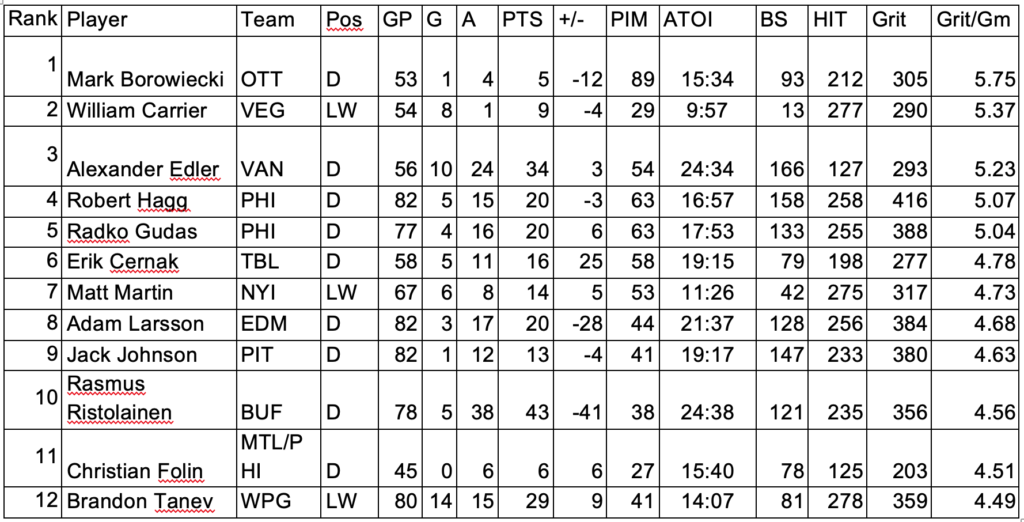
Well would you look at that! Johnson cracks the top 10 and Tanev is the #3 forward for Grit/Game. Based on this, it looks like GMJR has gotten his guys (and maybe the Penguins organization already made up a similar metric).
Hot Take!

While the list is here I’ll point out Ristolainen from Buffalo. Looks like exactly the type of player GMJR would like to get his hands on and is RD. While we all want Johnson to be the one moving out, Schultz only has a year left and Ristolainin has 3 at similar money, Schultz + Rust for Ristolainen and maybe picks/prospects to balance seems like a deal I could see GMJR wanting to make if Buffalo would bite.
Back to What makes the Tanev signing so curious when looking at Grit/Game is that the Penguins already have a similar player. Coming in at 24th in the league is none other than Zach Aston-Reese.

ZAR played fewer games but scores, blocks shots, and hits at a similar rate to Tanev. All for what was determined through arbitration to be worth only $1 million per season. Even though the stats are similar GMJR decided to spend three times more on Tanev because “that’s the way free agency works.” People defending the decision say

but statistics say

So the Penguins had an internal player just like the one they signed. Another thing of note is that the 12 grittiest players were generally defensemen and/or forwards that don’t put up very big numbers. Not too surprising since it is a requirement to not have possession in order to get a blocked shot or a hit. Now let’s have a look at the 12 least gritty forwards from last season:
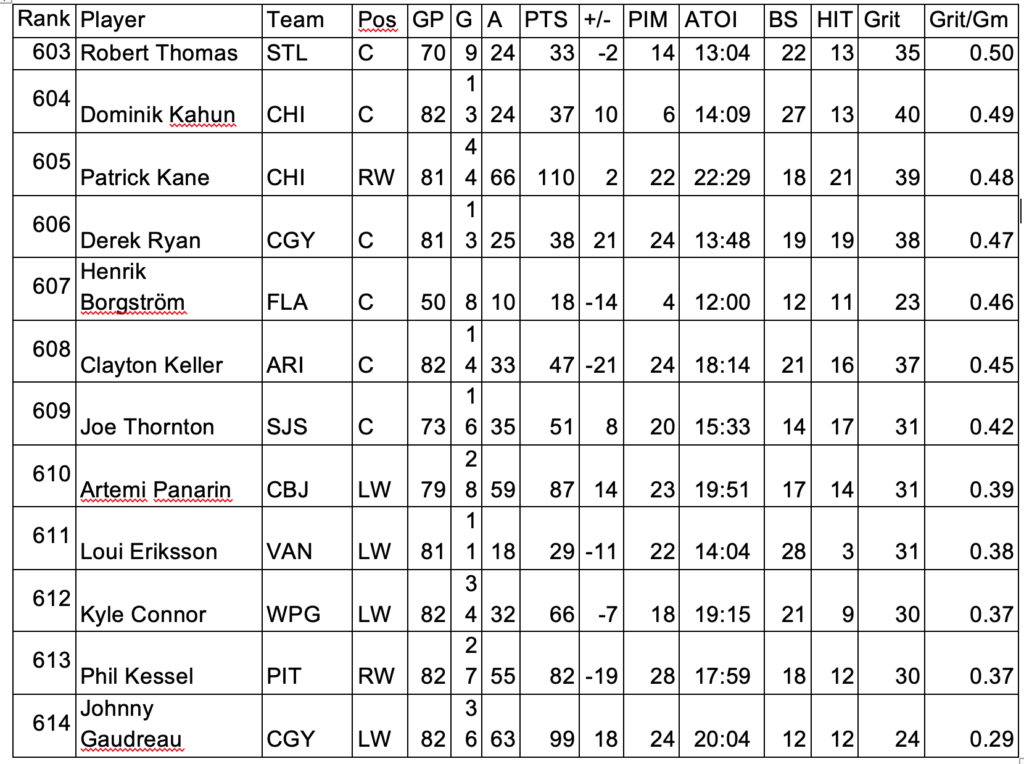
Not too surprising, mostly skilled and smaller forwards here. Ones that rack up lots of points. A few names that are interesting though. Kessel was the second least gritty forward in the league last year. Clearly jettisoning Kessel will improve the team’s grittiness. But another guy they picked up was Kahun, who is the 11th least gritty player in the league. Clearly grit isn’t the only thing GMJR cares about, but interesting to see players added at both ends of the grit spectrum.
Gritty Teams
Now let’s talk about team grittiness. This is where fighting is included because I was too lazy to do it for players but not too lazy to leave it out for teams. I wanted to get an idea of how grit translates to success. Thinking back to the back-to-back cup years the Penguins were built on speed and didn’t have the same level of grit/pushback they did the years after the cup runs. Is this a coincidence? How does it work for all the teams around the league? Let’s have a look at the data from the last 4 seasons (cup winner highlighted):
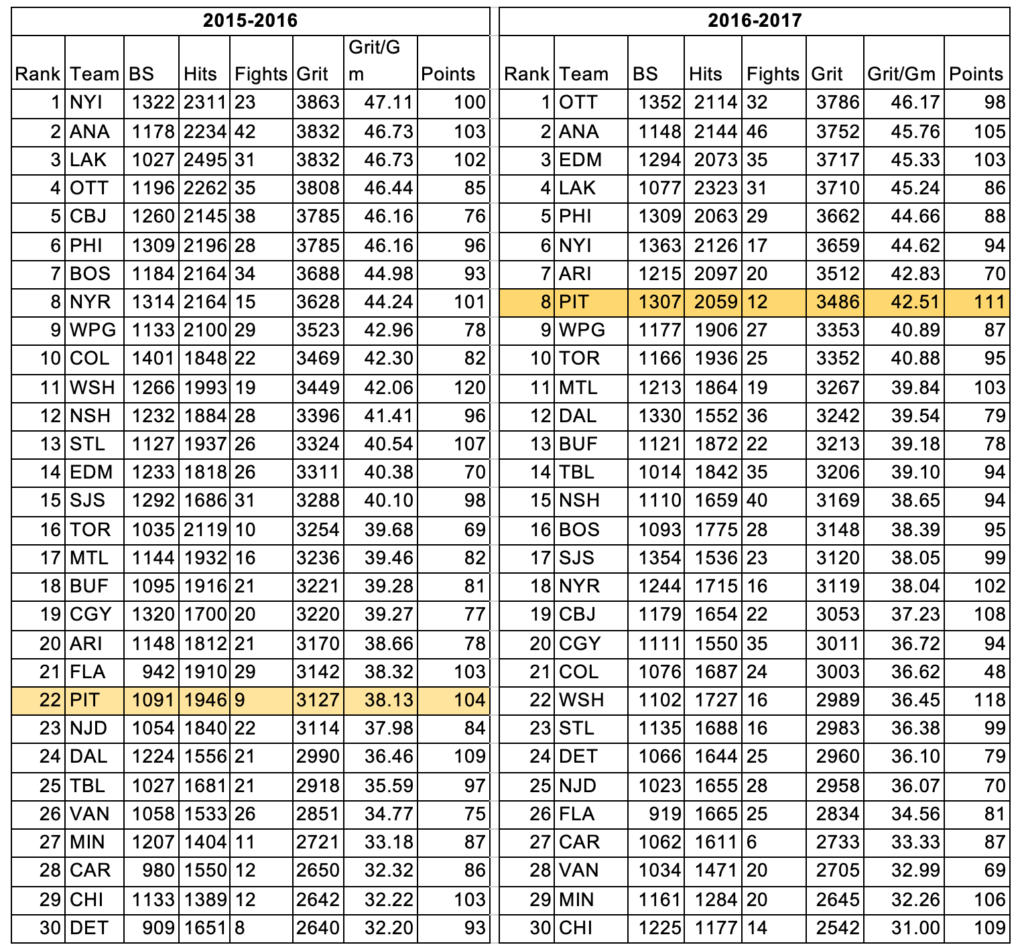
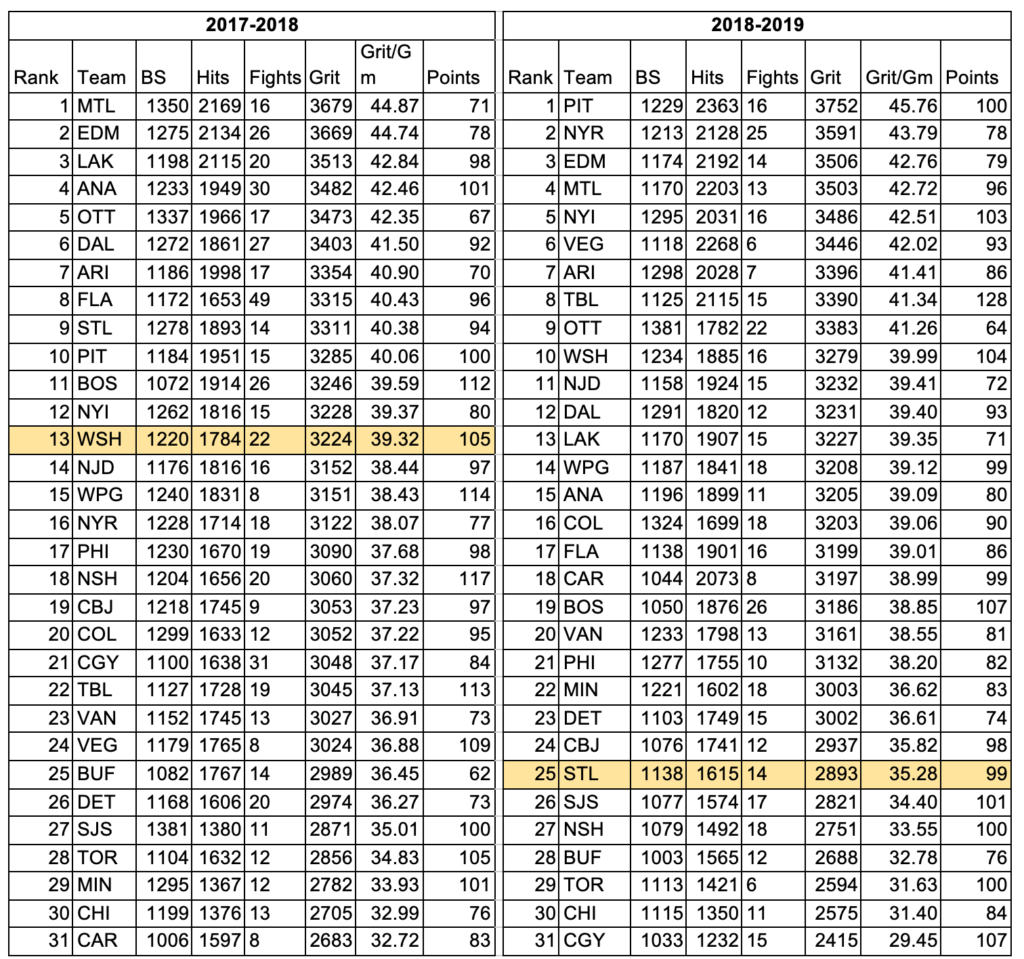
Lots of data here. Maybe the better teams tend to be less gritty like the Penguins were in cup years? Maybe it’s changed and grit translates to success? I went looking for a pattern but couldn’t really find one. Some interesting things that jumped out to me though:
- I tried with and without the fights and it didn’t materially impact the rankings
- The Penguins were the grittiest team last year
- The Penguins were grittier in the 2017 cup run year than we remember
- Calgary was last place in grit last year, clearly that’s why they acquired Lucic
- The Blues were surprisingly soft throughout the season, but they won anyway
Due to the last point about the Blues I figured I’d have a look at the playoffs this year (using Grit1 without fights because, laziness):
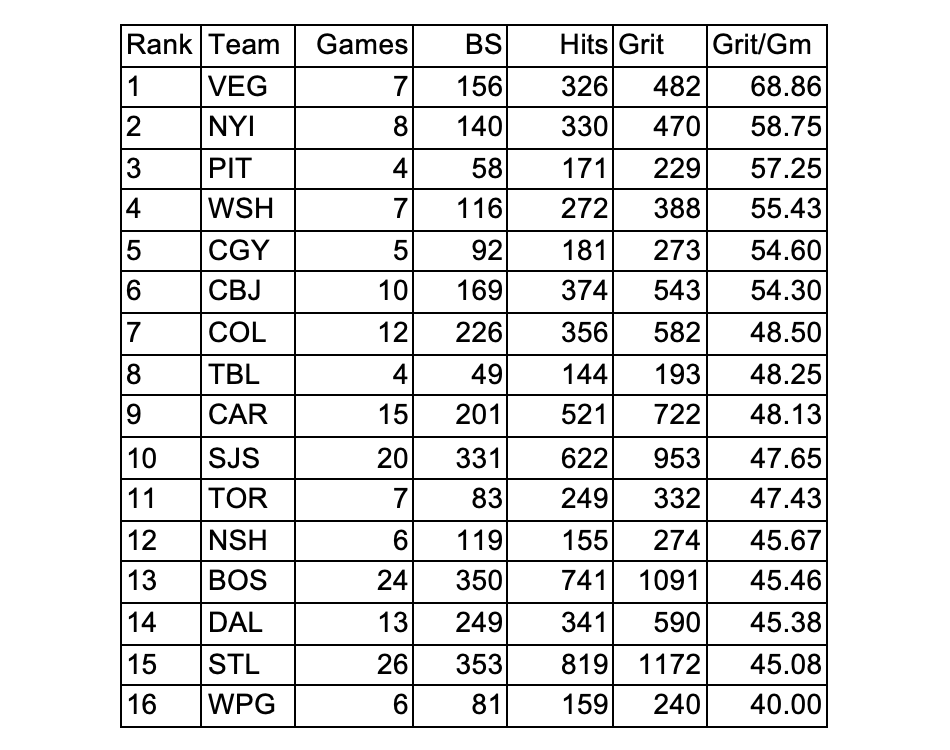
The Blues were still one of the least gritty teams in the postseason. Looks like it’s not just hits and blocked shots that make you hard to play against and win. But interestingly enough, the grit levels in the playoffs shoot way up, and this doesn’t even include the fights! The least gritty team in the playoffs would crack the top 10 in the regular season and only 5 of 16 were less gritty than the top regular season team. Clearly things amp up in the playoffs.

Playoffs aside, let’s dive into the patterns (or lack thereof) a bit more. I put together a graph for each year plotting grittiness vs. points as a measure of success and had some interesting results:

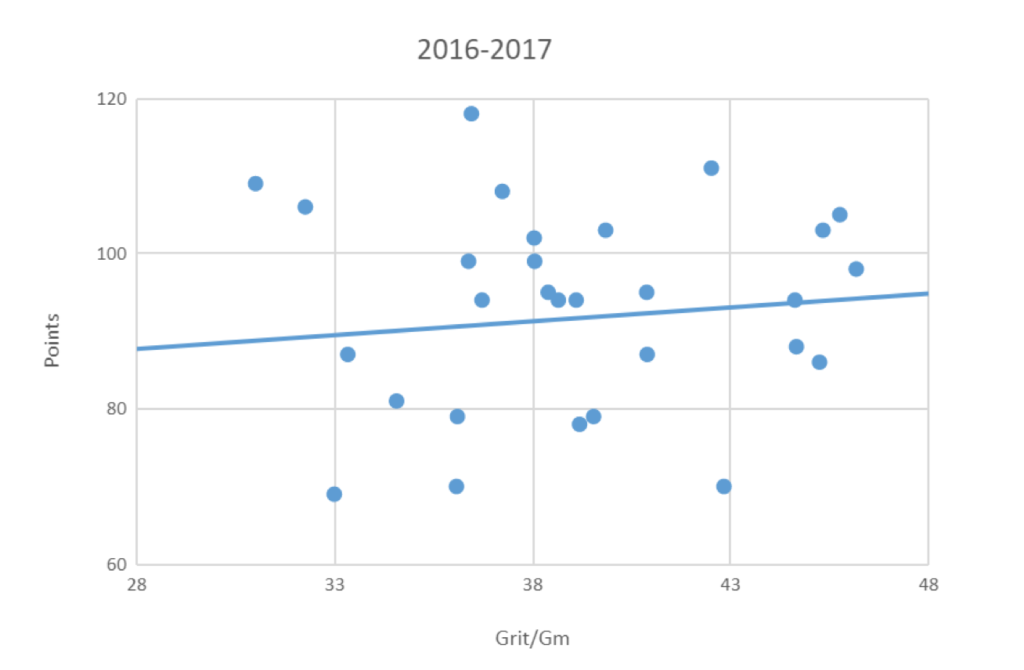
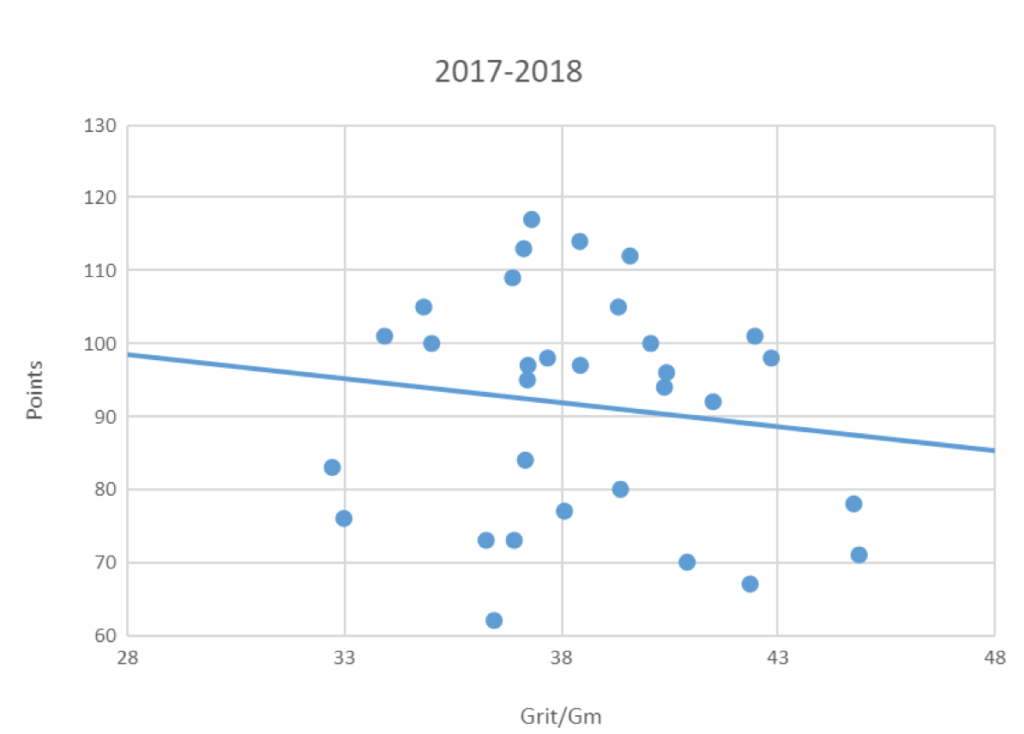
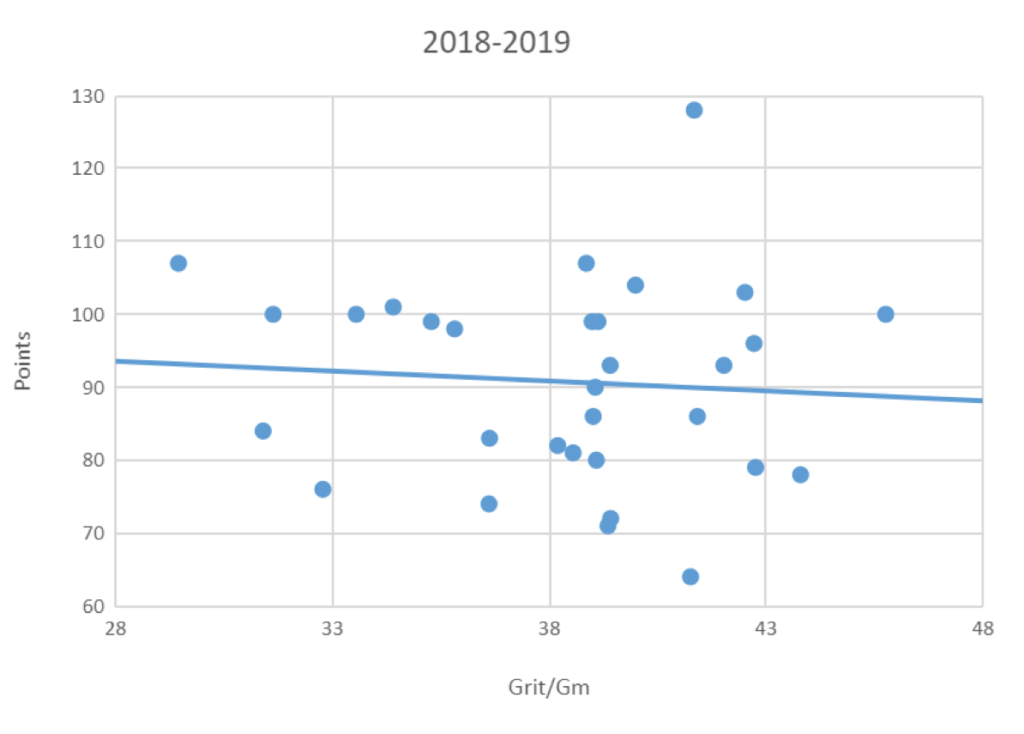
These scatter plots are all over the place! I added trendlines to see whether there was any significant link to grittiness to regular season results. The playoff results had a similar trendline.
All of this leads me to my conclusion: GRIT DOESN’T MATTER

So now we’ve created a metric to help us quantify the direction Rutherford and the Penguins are attempting to take and it seems that they are indeed getting grittier but that does not translate into Stanley Cups. As demonstrated above adding certain players to your roster does increase the overall grit of a team which can translate into “being tougher to play against.” A point often missed by the current front office is that “tougher to play against” and “tougher to beat” are not the same. If you’ve constructed a defense that allows more goals than your offense can score it doesn’t matter how tough those goals are for the opponents to get, they will still win. The Penguins statistically have achieved their goal of being tougher to play against, but a team with the 27th “best” 3rd defensive pairing isn’t tougher to beat, and that should be the focus.
